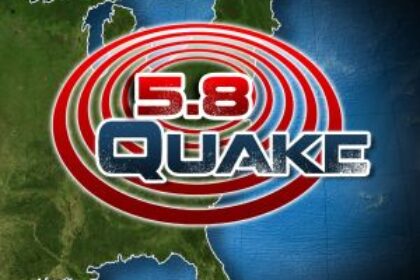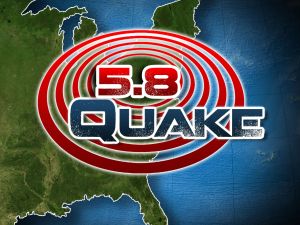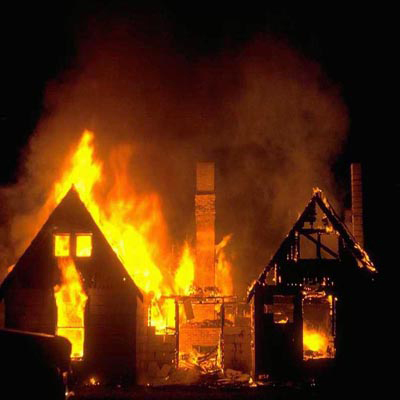
 Of all the things there are to worry about, earthquakes are fairly low on the list for those on the East Coast. So it was startling, just as the lunch hour was ending Tuesday and workers in a broad area of North America were settling back into their cubicles, when floors began to shake and chairs rocked.
Of all the things there are to worry about, earthquakes are fairly low on the list for those on the East Coast. So it was startling, just as the lunch hour was ending Tuesday and workers in a broad area of North America were settling back into their cubicles, when floors began to shake and chairs rocked.
In Clemson, S.C., water sloshed in glasses. In Washington, chandeliers swayed in the Capitol. And in the tiny town of Mineral, Va., china cabinets exploded.
An unusual earthquake centered near Mineral startled millions of people from Maine to Georgia on Tuesday. In the end there were few reports of serious damage, with more rattling of nerves than of property.
But the tremors disrupted life in some of the nation’s biggest population centers. Tens of thousands of people were evacuated from office buildings. The quake strangled cellphone service, interfered with air traffic, halted trains, jammed roadways and gave some on the West Coast an opportunity to poke fun at Easterners who seemed panicked and uncertain of how to respond. In earthquake-prone areas, people usually are instructed to stay inside to avoid falling debris, but in a post-Sept. 11 world, few argued with evacuation commands.
The United States Geological Survey said the quake struck at 1:51 p.m. It preliminarily measured 5.8 and lasted 20 to 30 seconds. Survey officials reported two small aftershocks, of magnitude 2.8 and 2.2, within 90 minutes of the original jolt. Seismologists, suggesting little cause for further alarm, said the initial quake erupted from an old fault, which, unlike the San Andreas fault in California, normally produces much weaker quakes.
This quake was notable for its incongruity: it was one of the most powerful to hit the East Coast in decades, and yet it caused little damage. Reports of tremors came from as far north as Sudbury, Ontario, where government offices were closed, and as far south as Alabama.
Thousands of people in Midtown Manhattan were evacuated from their offices and found themselves suddenly sprung on a sunny summer afternoon. Farther downtown, police officers ordered the evacuation of City Hall, sending Mayor Michael R. Bloomberg and his staff scurrying out of the building.
But for all the disruptions and the fleeing of buildings, the quake was, for most people, a curious interruption before life quickly returned to normal, providing fodder that lighted up social media sites. “Felt a litle wobble here is Astoria, but none of my Scotch fell off the shelf,” a man who identified himself as William Schroeder posted on an Nytimes.com message board.
Others were more shaken. “I ran outdoors and found my neighbor calling a friend in Virginia who also felt the profound quake,” Bill Parks of Hummelstown, Pa., said in an e-mail. “This quake was like none I ever experienced in the East in my life and I am 76 years old.”
In Washington, the quake led to the quick evacuations of the White House, the Capitol and monuments across the Mall. Air-control towers across the region were evacuated, putting some planes in a temporary hold pattern and diverting some to Boston. Amtrak stopped its trains. The Federal Emergency Management Administration asked the public to refrain from talking on cellphones and to use e-mail and text messages instead in an effort to relieve the congestion.
The epicenter in Mineral is about 84 miles southwest of Washington, and a few miles from a nuclear power plant. Dominion Virginia Power, which owns the plant, said that its units tripped off line automatically as planned and that no damage to the plant had been reported.
Perhaps the most trauma occurred in Mineral itself. The quake stopped everything for hours. Schools closed. Coffee shops shut down. At the Food Lion, on the outskirts of town, managers shooed reporters away but not before one employee said: “The whole floor was going up and down. It was crazy in there.”
Ben Pirolli, 68, who co-owns Main Street Plumbing and Electrical, said he was in the bathroom when the quake hit.
“I was mopping the floor and the next thing you know, everything is falling in on me,” Mr. Pirolli said. “I thought the world was coming to an end.”
Geologists said that the region had frequent earthquakes but that they were usually so small that they were hardly noticed. This one was 3.7 miles deep, bigger than is typical, and produced a rumbling that grabbed the attention of millions of people hundreds of miles away from the epicenter.


